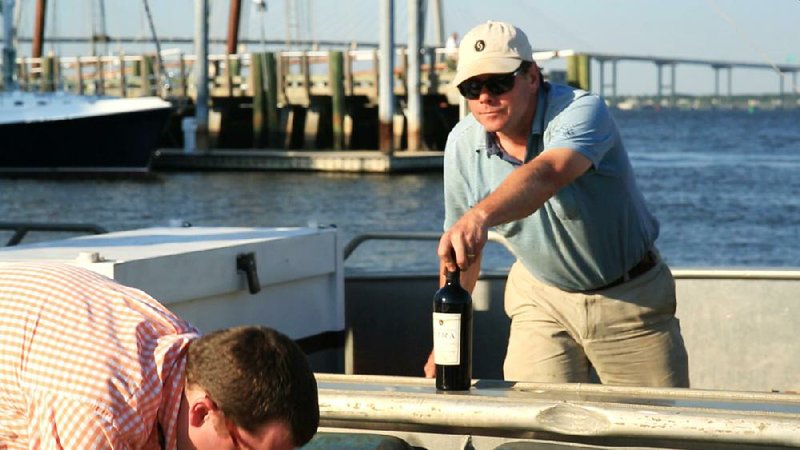Two weeks ago, Jim "Bear" Dyke Jr. was on a boat that pulled seven metal cages, each containing a case of wine, from Charleston Harbor in South Carolina.
Dyke, an Arkansas native and president of Mira Winery in St. Helena, Calif., is experimenting with undersea aging of bottles of cabernet sauvignon to see whether factors such as temperature, water flow, light and pressure could speed up the time needed for a wine to mature.
"What we're doing will seem absolutely insane until it's not. And when it's not, a lot of other people might start doing the same," Dyke said Friday.
In the wine industry, "most people have been fairly dismissive" of the underwater aging concept, Dyke said, adding that most believe if you start with the finest grapes in Napa and a winemaker capable of producing highly rated wines, then that should suffice.
Dyke, the son of retired Little Rock businessman James Dyke, graduated from the University of Arkansas at Fayetteville before moving to Washington, D.C., where he became active in Republican politics, including several presidential campaigns and serving as communications director for the Republican National Committee. He and his wife moved to Charleston in 2005, where he founded a public-affairs/communications company.
Dyke and Mira's winemaker, Gustavo Gonzalez, struck up a friendship in 2005 and quickly realized both were interested in trying new approaches toward crafting wine. That, he said, takes experimentation and time.
About a year and a half ago, the two took a hard look at their winemaking process, "from bud to bottle." They discussed grape growing (Mira buys grapes from seven vineyards in Napa's Rutherford District), fermentation tanks and processes, and aging. He said Mira produced 9,500 cases last year and sells its wine in eight states, including Arkansas.
Dyke said he and Gonzalez thought they could come up with a way to challenge the traditional method developed by French vintners of storing wine in warehouses or cellars at a constant 55 degrees. Then Dyke said he came across a story about bottles of old champagne being recovered from a shipwreck and another article about a French winery experimenting with storing large containers of wine in the ocean.
That led to the idea of ocean aging, called "aquaoir" by Mira. By putting bottles in the ocean, the thought was that winemakers could change factors that dictate aging: temperature, light, pressure and motion.
"A bunch of people said that we were crazy, and three months was no amount of time and it's not going to be different," Dyke said.
At the time, the temperature of Charleston Harbor was 53-54 degrees, so the winemakers moved quickly to have four special cages built, then anchored them 60 feet down. Dyke said the cages were designed to allow water to flow through, and the bottles were attached to wooden slats in a way that allowed some movement.
In a blind taste test comparing the first batch of wine pulled from the water with one aged using traditional methods, one advanced sommelier from Charleston pronounced that the time underwater had improved the wine, turning a 2009 vintage into the equivalent of a 2007, Dyke said.
Last fall, a second set of bottles from the winery's 2011 vintage was immersed for six months. That wine, pulled up on May 6, tasted younger than comparable bottles stored in more traditional fashion, Dyke said.
Lorri Hambuchen, who writes the "Uncorked" wine column for the Arkansas Democrat-Gazette, was at the Little Rock tasting in November that Mira held -- one of seven held in U.S. cities -- where participants compared the first batch of ocean-aged wine with land-aged bottles of the same vintage.
"It was a very intriguing tasting," said Hambuchen, who is a member of London's Institute of Wines and Spirits. "It does have that taste that you can tell [a wine] has age behind it," but it wasn't that old.
Hambuchen said three things control aging: temperature, light exposure and no movement. While temperature and light are easy to keep constant, movement likely is the key.
"That movement was probably the biggest difference, I would have said," she said. Variation in temperature is not going to accelerate it as long as it is constant.
Most wines being made today aren't meant to be aged, Hambuchen said, resulting in few producers looking for ways to speed up the aging process. Even so, efforts to develop ways to get that "aged" taste faster makes sense, she added.
Dyke said it is too soon to say exactly what factors are having an effect on the ocean-aged wines.
But, if tests show that wine can be matured more quickly via underwater aging, the next step will be to see whether those conditions can be matched on land in a commercially sustainable fashion, Dyke said.
"In a world that demands ready-to-drink wine, when [bottles of 2012] come out, they want to drink them as if they've already been cellared for five years," said Dyke. "There is the potential for a significant benefit on the business side."
Dyke said Mira plans to place more wine in the harbor this fall for six months. They'll leave more of the 2011 vintage as well as some of the 2012 vintage, which has just been bottled. They'll also pull up one cage that was left underwater longer to see what effects summer water temperatures, expected to rise above 70 degrees, will have on the wine.
"I would love it if like five other wineries would do this" to broaden the amount of information about the concept, he said, noting the time needed for such experiments. Even so, Mira's tests will continue.
"We can begin to get more data and then really see and make, hopefully, some decisions or conclusions about what it is impacting and how," he said.
Monday Business on 05/19/2014
